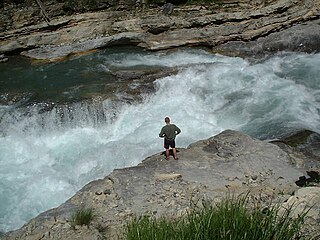
The Bealey River is a small river located in the Southern Alps of New Zealand. It is a tributary of the Waimakariri River. Its valley forms the eastern approach to Arthur's Pass. The river and the Bealey settlement are named for Samuel Bealey, a 19th-century Superintendent of Canterbury Province and pastoralist.

Westfield railway station was a station of the Auckland railway network in New Zealand. The station closed to all services on 12 March 2017, following an announcement by Auckland Transport on 17 January 2017, because fewer than 330 passengers used it daily and it required a costly upgrade.

The NZR T class was a class of steam locomotive used in New Zealand. They of the "Consolidation" type, popular in North America, especially with the narrow gauge Denver and Rio Grande Western Railroad.

The NZR WB class was a class of tank locomotives that operated in New Zealand. Built in 1898 by the Baldwin Locomotive Works, the twelve members of the class entered service during the first five months of 1899. Eight were withdrawn by the end of 1935, while four others survived with new boilers until the mid-1950s.

The NZR WD class was a class of tank locomotive built by Baldwin Locomotive Works to operate on New Zealand's national rail network.

The N class were 12 steam locomotives that operated on the national rail network of New Zealand. They were built in three batches, including one batch of two engines for the private Wellington and Manawatu Railway Company, the WMR, by the Baldwin Locomotive Works in 1885, 1891, and 1901. Previously the N class designation had been applied between 1877 and 1879 to Lady Mordaunt, a member of the B class of 1874.

The Wellington and Manawatu Railway Trust is a charitable trust based in Wellington, New Zealand, and is actively restoring former Wellington and Manawatu Railway locomotive No.9, to full working order.

Summerlea is a lightly populated locality on the West Coast of New Zealand's South Island.

Hector and Ngakawau are two lightly populated settlements located at the mouth of the Ngakawau River in the West Coast region of New Zealand. Both settlements are situated on State Highway 67 between Westport and Karamea. The 2001 New Zealand census found that Hector and Ngakawau have a combined population of 300, a drop of 16% or 57 people since the 1996 census. This has dropped further in 2006 to 234 people. Despite a low population, many of the workers at New Zealand's largest open-cut coal mine at Stockton choose to live at these places and shuttles frequently operate between the two places.
The Conns Creek Branch was a 2.7 kilometre branch line railway in the West Coast region of New Zealand's South Island. It diverged from the Seddonville Branch at Waimangaroa and followed the southern bank of the Waimangaroa River to the line's terminus at Conns Creek at the foot of the Denniston Incline. The line operated from 1877 until 1967 and existed for the sole purpose of conveying coal from mines to the port of Westport.
The Mokihinui Hydro was a proposed hydroelectric dam and power station planned for conservation land on the Mokihinui River on the West Coast of New Zealand. The project by Meridian Energy was expected to cost $300 million.
The Hemphill River is a river of the northwestern South Island of New Zealand. It flows through rugged country to the south of Kahurangi National Park, forming two small lakes on its route south to join with the Mokihinui River.

Omoto locomotive dump is a New Zealand Railways locomotive and rolling stock dump site located near Greymouth, New Zealand. The dump site is located on the southern bank of the Grey River, close to the Midland Line and State Highway 6.

Oamaru locomotive dump was created in New Zealand so that obsolete locomotives and rolling stock could be used to stabilize loose ground where rivers and the coast were eroding the ground where the railway lines were built. This was done at a time when scrap steel was an uneconomic proposition. It was located on the coastline in the North Otago town of Oamaru to stabilise land used by New Zealand Railways for their freight yards. Here the coastline of the Pacific Ocean pounded heavily against the land causing major erosion.
















